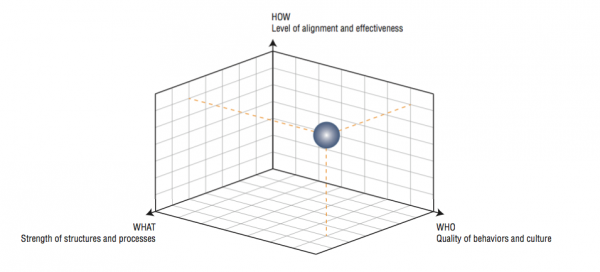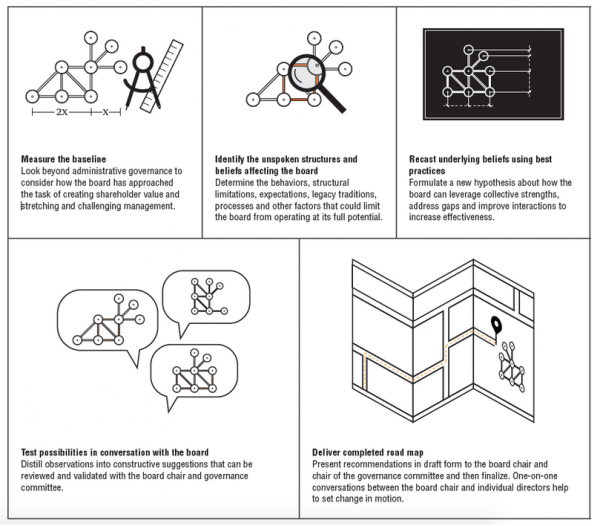The annual visit to the doctor for a physical exam is an ironic ritual of modern life. After all the questions and tests, the desired outcome is to hear that nothing is wrong. While freedom from illness is a very good thing, there is a big difference between that and being in peak condition. How much more informative would the annual checkup be if it could tell us not just how to avoid sickness but how to be stronger and more flexible and have greater endurance? Rather than being a chore, the exam’s insights might make it something to look forward to.
An annual board assessment has become the boardroom counterpart to the routine physical exam in the years since such an assessment first was mandated by the New York Stock Exchange (and subsequently adopted by many companies not listed on the exchange). These lengthy questionnaires, in which directors typically rate themselves, the board as a whole and its committees, screen for problems rather than for the optimization of performance. Not surprisingly, these assessments often result in high scores and few actionable suggestions for improvement. But just as people seeking a more complete picture of their health can undergo additional fitness testing, boards looking for an understanding of how to reach their full potential can supplement a traditional assessment with a board effectiveness review.
A board effectiveness review includes an in-depth, individual interview with each board member conducted by an experienced facilitator. The interviews are both confidential and structured. Rather than simply rate performance, directors are asked to describe how the board reaches consensus, operates under stress and interacts with senior management. The interviews also examine what the board focuses on, both in its meeting agendas and in its overarching strategic decisions. Finally, directors delve into the who of the board by describing the interaction of board members and the tone of board discussions. Analysis of these inputs results in a detailed mapping of the board and its operating environment.

Figure 1. Mapping The Board's Overall Effectiveness
From that initial overall assessment, the facilitator begins constructing a vision of high performance. After benchmarking the board’s current practices, observations gathered from the interviews are used to uncover behaviors, structural limitations and other factors that could be undermining the board’s efforts. Once those problem spots are identified, the group’s strengths and current best practices are combined to point the way to new possibilities. These potential changes in the board’s procedures, practices and culture are refined in conversation with the board chair and governance committee. The review deliverable concludes with a concrete road map for improvement that is presented to the board chair and the chair of the governance committee in draft form, allowing them to work with the facilitator in shaping the final wording to sidestep potential landmines that could undermine the board’s acceptance of the recommendations.

Figure 2. A Plan For High Performance
Some boards also use the effectiveness review as an opportunity for peer evaluations that generate constructive feedback for individual directors. Each director is evaluated across the four core boardroom performance behaviors: strategic orientation, results orientation, collaboration and independence. To maintain confidentiality, only issues highlighted by multiple board members are incorporated into suggestions for a director’s improvement, and those observations and suggestions are given only to the board chair and chair of the governance committee to use as they see fit in their mentoring of individual directors.
Peer evaluations can be sensitive undertakings, but when they are conducted diplomatically by a skilled facilitator, they can provide constructive feedback that is much appreciated. Indeed, our experience has been that directors are eager for concrete suggestions that can make them more effective contributors in the boardroom.
Each board that undergoes an effectiveness review does so facing different issues and objectives, as is illustrated in the following three case studies.
Case 1: Fixing a Power Bottleneck
One board with whom we worked wanted help in sharpening its decision-making ability. The board had a relatively new CEO who served as the board chairman as well. The board also had an outspoken, long-tenured lead director, and there was concern that that director’s forcefulness might make it difficult for the CEO to find his footing. So while the lead director frequently chaired the governance committee, the decision was made to split those roles when the CEO joined the company and, thus, place the long-tenured lead director in charge of the governance committee and move another director into the lead director role.
While this might have seemed like a good idea on paper, in practice it backfired. Without clear boundaries between the remits of the lead director and the chair of the governance committee, the latter ended up dominating not just the lead director but essentially running the board. A groupthink mentality set in, resulting in a set of behaviors that stifled discussion and decreased the board’s willingness to debate central issues. In this case, the structural change had exacerbated rather than relieved a challenging interpersonal dynamic. The effectiveness review was well received as directors welcomed the opportunity to share their perspectives and help highlight areas for improvement. The board addressed its problems through a number of actions, including instituting term limits, recombining the lead director role with that of the governance committee chair, and bringing in new directors, which allowed the board to add some needed industry expertise and balanced perspectives.
Case 2: Centering a Board out of Balance
Sometimes the structure of the board appears sound and directors seem to be filling their role correctly, but performance still lags because the board’s collective focus has not kept up with the company’s changing needs. In one case, the board of a mid-market cap company wanted to see if it was aligned with the company goal of growing in size and sophistication to position itself for a transformative acquisition. Based on the board’s most recent assessment, everything looked to be in place: The board structure seemed appropriate, and the board understood its mission and purpose. The interactions of the board as a team were positive, and the chair placed a priority on mentoring the CEO. But a problem became clear in the effectiveness review of the peer behaviors of strategic orientation, results orientation, collaboration and independence. Because many of the directors had been elected when the firm was smaller and its goals were different, the directors tended to view issues through an operational rather than a strategic lens. This led to inefficiencies with the board’s time, as discussions wound through the rabbit trails of detail rather than staying focused on the big picture. When the board was asked to articulate the top three issues facing the company, the eight directors highlighted 19 different items — underscoring a clear lack of alignment within the boardroom. When directors were asked about their view of the board’s performance, there was widespread agreement that the board did not fully utilize the skills and knowledge of each member and that some board members were taking too much airtime.
After our analysis, the governance committee formed an interim strategic review committee to help reinforce alignment and concentrate on the right priorities. The chairman took a more active role to ensure balanced discussions and to encourage desired behaviors both in and out of the board meetings. As a result, the board made better decisions and was able to unlock significant shareholder value.
Case 3: Getting Ready for Prime Time
On occasion, a board effectiveness review illuminates changes that need to be made not only in the boardroom but also in the C-suite. A private equity-backed firm had its board assessed as it prepared to go public. One of the defining characteristics of this board was its relationship with the CEO. The board chair — representing the company’s major shareholder — spoke with the CEO almost daily and essentially was managing company operations from the boardroom. The rest of the board followed suit, not merely stretching and challenging management but directing it. The unintended consequence was that management did not adequately develop the ability to work in ambiguous situations, take risks and independently take action to address key levers in what had become a $2 billion company. The board, sensing that management continued to lack these important competencies, kept its hand on the rudder — creating a vicious cycle that prevented competency growth from taking place.
We determined that the board needed to change some of its behaviors and learn to stretch and challenge management without running the company. To give management the space needed to become capable of leading the business with fewer strings attached, we worked with the chairman to reframe his approach from managing the CEO to developing the CEO. We also counseled the board to use its committees to establish principles that guided management behavior without dictating it. For example, the compensation committee implemented best practices to influence executives by more directly linking compensation and related metrics of success to the company’s strategic priorities. The nominating and governance committee similarly adjusted its approach to governance and board nominations based on benchmarking best practices, which included an analysis to identify gaps in boardroom expertise. The end result was not only a successful initial public offering but a recharged management team that controlled the company’s destiny — and went on to deliver results that surpassed investor expectations.
A Powerful Tool for Insight
In addition to the benefit of being able to address critical issues, undergoing a probing effectiveness review often provides a much-needed opportunity for the board to step back and focus energy on itself. The result is a board that is reinvigorated and recommitted to a best-practice orientation. As the legendary management guru John Gardner observed, most groups can solve their problems once the problems are clearly seen and understood. A board effectiveness review is not as much science as it is art — the art of helping directors articulate in a constructive and actionable way those insights they already have regarding how the board can maximize its performance.
Board performance is under greater scrutiny by more stakeholders than ever before. Yes, board assessment is a compliance issue, but it can be far more than that — it can determine the extent to which the board truly is acting as a strategic asset to the organization. A board effectiveness review offers, in a confidential setting and with a modest time investment, a powerful framework for a board to evaluate and optimize its collective ability to assess company business strategy and direction, appoint and mentor the CEO, and oversee capital allocation as the guardian of shareholder value.





